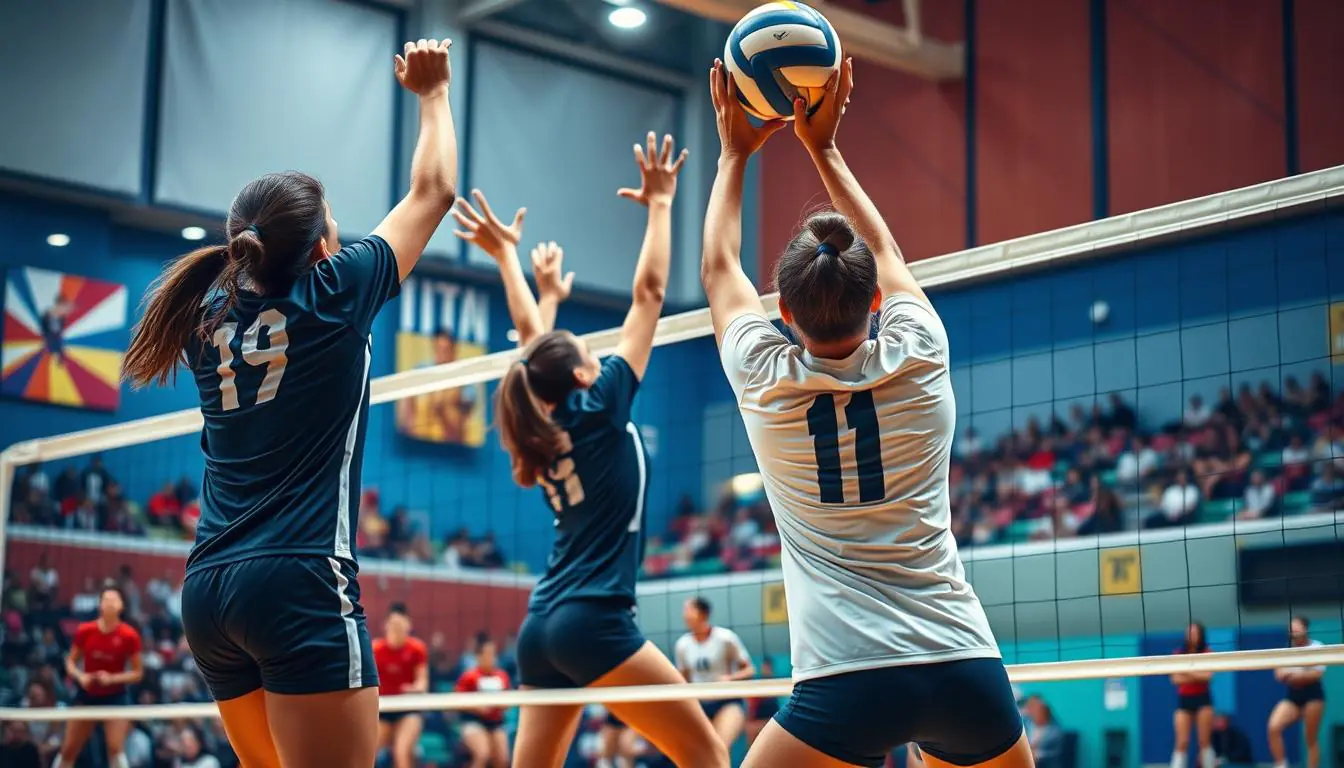The championship match was seconds away from decision. Sarah, our team’s lead blocker, stood poised at the net, her eyes locked on the opposing team’s hitter. This moment would define our entire season of mastering volleyball defense.
Volleyball is a game of split-second decisions and lightning-fast reflexes. Reading hitters and executing perfect blocks isn’t just a skill – it’s an art form that separates good teams from great champions. Our guide will dive deep into the world of volleyball blocking techniques, revealing how top athletes anticipate and neutralize attacking strategies.
The 3-step crossover blocking footwork pattern stands as the gold standard for professional and collegiate volleyball players. Understanding this fundamental technique can transform your defensive game, making you an unstoppable force at the net.
Key Takeaways
- Master the essential volleyball blocking techniques
- Learn to read hitter approaches and body language
- Understand the critical 3-step crossover blocking method
- Develop strategic defensive positioning
- Improve team coordination in blocking
Understanding the Fundamentals of Blocking

Volleyball blocking is a key defensive skill that changes how the game is played. Learning volleyball blocking techniques needs smart thinking and exact moves. Players must learn how to defend well, not just by where they put their hands.
Role of Pin Blockers in Defense
Pin blockers are vital in reading hitters and keeping the court safe. Their main jobs are:
- Studying the opponent’s hitting patterns
- Keeping the right spot on the court
- Telling teammates where the attack might come
Importance of Reading Hitter Approaches
Good blocking starts with knowing how hitters act. To defend well, players need to watch closely and make quick choices. They must be able to guess where the attack will come from.
“Defense is not just about blocking – it’s about reading the entire offensive strategy” – Volleyball Defense Expert
Team Coordination in Blocking Strategy
Blocking works best when the team works together. The bunch read blocking system helps the team cover the court well. This lets 2-3 players quickly react to the attack.
| Blocking Element | Key Considerations |
|---|---|
| Footwork | 2-step and 3-step shuffle techniques |
| Positioning | “Elbows to elbows” spacing method |
| Eye Focus | Track setter, then hitter’s approach |
By using these methods, teams can build strong defenses. This can stop the opponent’s attacks and open up chances to score.
Key Visual Cues for Reading Hitters
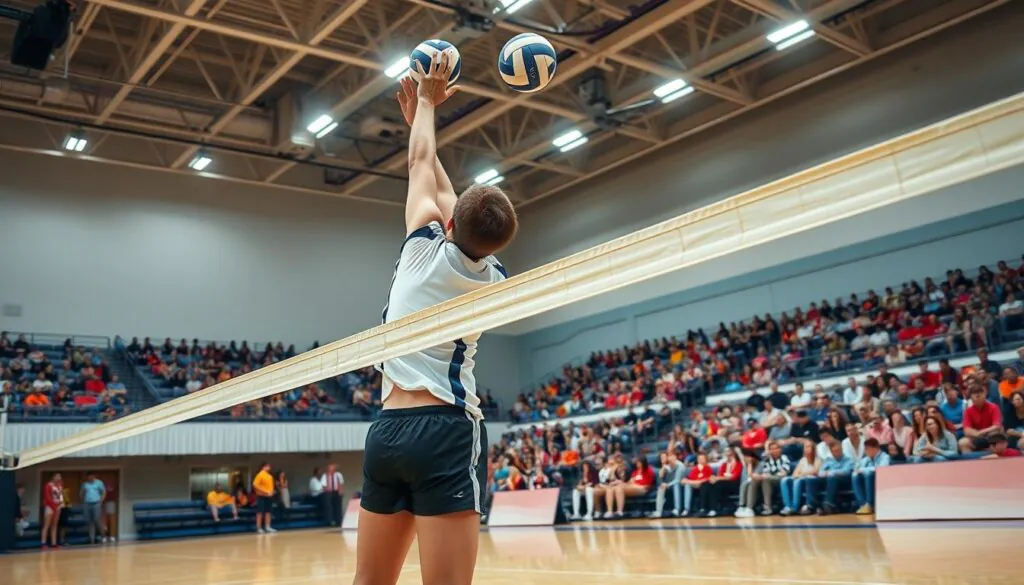
Mastering volleyball blocking techniques means learning to spot subtle signals from hitters. It’s an art that sets top defenders apart. By understanding visual cues, we can guess a hitter’s plan before they attack.
Ball Set Analysis
The ball’s path tells us a lot about the attack. Skilled blockers watch for:
- Set height and angle
- Distance from the net
- Speed of the incoming set
- Setter’s body positioning
Hitter’s Approach Angles
Knowing the hitter’s approach angle helps predict their attack. Defensive strategies improve when we can guess their path.
| Approach Angle | Potential Attack Type | Defensive Response |
|---|---|---|
| Steep Approach | Power Spike | High Block Positioning |
| Shallow Approach | Tip or Roll Shot | Lower Block, Ready to Move |
| Angled Approach | Cross-Court Attack | Shifted Block Coverage |
Body Language Indicators
Elite players know that body language shows a lot. Key signs include:
- Shoulder rotation
- Hip positioning
- Arm swing preparation
- Foot placement before jumping
Pre-Hit Movement Patterns
Successful reading hitters means studying their pre-hit moves. Blockers need to spot small changes in footwork and body mechanics. These changes hint at the attack strategy.
“Seeing before believing is the essence of great volleyball defense.” – Volleyball Defense Expert
Advanced Set Analysis
Understanding advanced set analysis is key for good defensive strategies in volleyball. It starts with knowing how sets affect attacking chances.
Volleyball blocking needs a deep understanding of set types and their game impact. Skilled players quickly react to different set dynamics with fast reflexes.
Pin Set Dynamics: Decoding Outside Hitter Strategies
Pin sets test blockers with fast side-to-side moves and smart positioning. Defensive players must:
- Track the ball’s path
- Look at the setter’s hand position
- Guess attack angles
- Stay quick on their feet
Short Set Characteristics: Tempo and Precision
Short sets require middle blockers to react fast. These quick sets put a lot of pressure on the defense. They need to make quick decisions and work together.
Impact of Ball Location on Defensive Positioning
Where the ball is tells a lot about the hitter. Setters use different spots to help their attackers. Blockers must always change their defense.
Set Trajectory Assessment Techniques
Top volleyball players know a lot about set paths. They understand the speed, height, and angle of sets. This helps them guess and stop attacks better.
“Mastering set analysis is like reading an opponent’s chess moves before they happen.” – Volleyball Performance Coach
Hitter Behavior Analysis
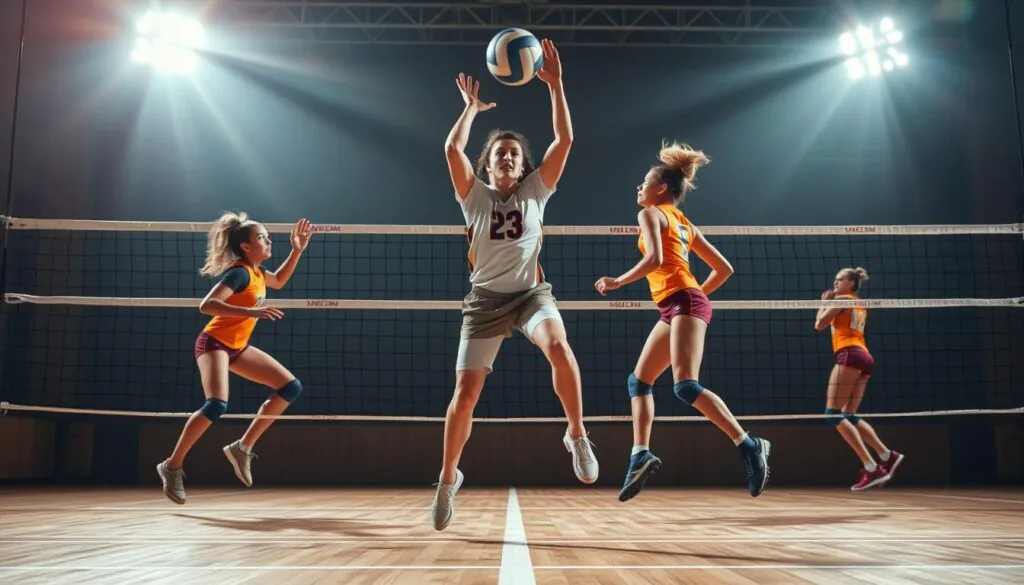
Understanding hitter behavior is key to good volleyball blocking. It’s about watching their moves, how they approach, and their attack style.
Good defense starts with knowing the hitter well. Players need to spot small signs that show how they might attack.
Pass-to-Hit Transition Insights
The pass-to-hit transition is very telling. Blockers should watch:
- Where they stand after the pass
- How they’re facing
- How fast they move
- How close they get to the attack line
Approach Pattern Recognition
Every hitter has their own way of moving. Good defenders can learn these patterns to guess their attacks.
- Look at their step rhythm
- See how far they are from the attack line
- Watch their body’s momentum
- Find out their favorite hitting angles
Timing Variations and Hitting Tendencies
Timing is everything in volleyball defense. Hitters use small timing changes to get an edge:
“Anticipation separates good defenders from great ones.” – Volleyball Training Expert
- They might attack quickly near the net
- They might delay to confuse blockers
- They change arm swing speeds
- They might change direction suddenly
Learning to read hitters can make a big difference. It helps players be more proactive in blocking and countering.
Strategic Blocking Positions
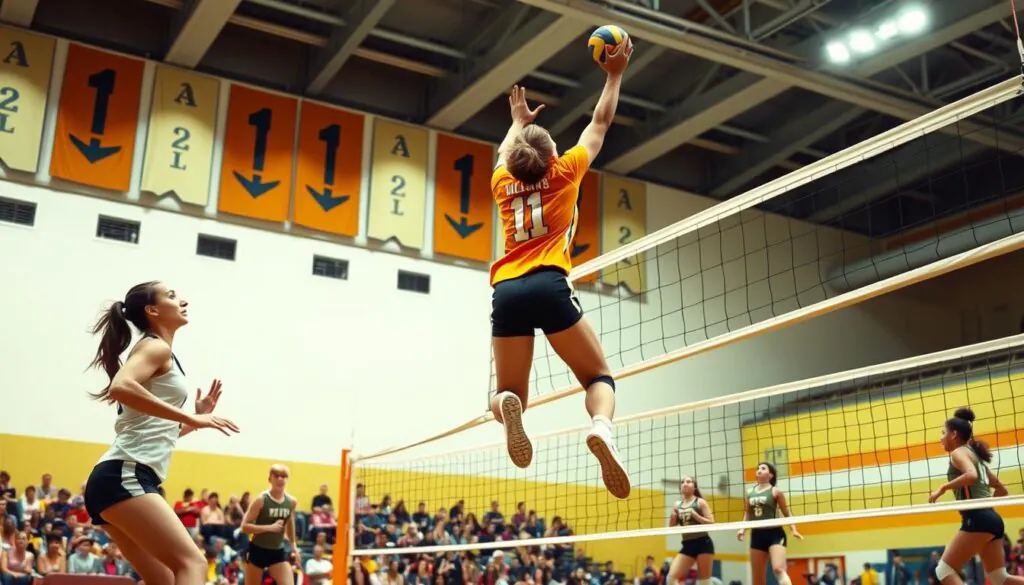
Volleyball blocking needs precise positioning and smart thinking. Good defense comes from knowing how to read hitters and use the court well. Players must be quick to react and understand space to block shots effectively.
Line Shot Defense Fundamentals
Stopping line shots requires great positioning and fast moves. Blockers should:
- Stand close to the sideline
- Position hands for straight shots
- Watch the hitter’s body
- Guess where the shot will go
Cross Court Coverage Techniques
Cross court shots are tough for blockers. Good defenders learn to:
- Adjust for diagonal shots
- Read the setter’s cues
- Work with back-row players
- Understand the shot’s angle
Power Shot Prevention
Stopping strong shots needs smart placement and skill. Defenders should:
- Jump at the right time
- Block high
- Block wide
- Stay tense during the block
Gap Management Strategies
Keeping gaps small is key for good defense. Good gap management means:
- Staying in touch with teammates
- Moving together
- Reading the hitter’s moves
- Adjusting quickly
“Blocking is not just about height, it’s about intelligence and positioning.” – Volleyball Coaching Experts
Getting better at blocking takes practice and teamwork. Players who work on blocking skills will get better at defending.
Block Timing and Execution
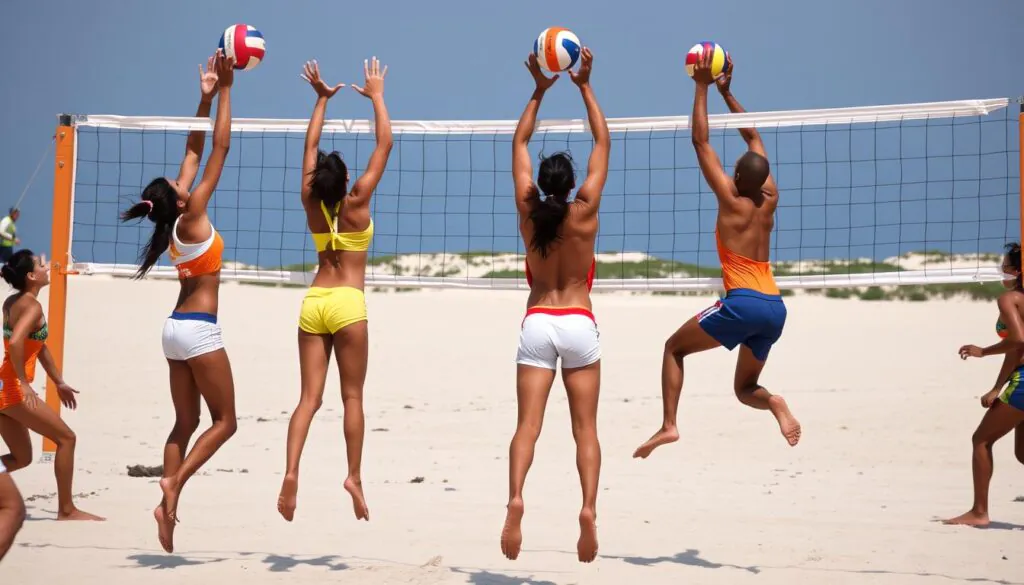
Volleyball blocking needs precision, timing, and smart thinking. It’s about mastering the details of defense and reading hitters well.
To block well, players must put together several key elements. They need to read hitters to stand out.
Jump Timing Mechanics
Getting the jump timing right is essential. Blockers should:
- Match their jump with the hitter’s move
- Watch the setter’s body
- Guess where the attack will hit
Hand Positioning
Good hand placement is vital for a strong block. Important steps include:
- Spread fingers wide
- Keep wrists firm
- Reach over the net
Block Formation
Blocking well needs teamwork. Different methods help cover the court better:
| Blocking Technique | Key Characteristics | Strategic Purpose |
|---|---|---|
| Swing Block | Mimic hitter’s arm path | Change the attack angle |
| Stuff Block | Reach high | Stop the ball from crossing |
| Read Block | Follow the hitter | Guess the attack |
Recovery Techniques
Quickly getting back to defense is key. Players should:
- Be ready for the ball
- Get back into position
- Talk to the back-row defenders
“Blocking is not just about height, it’s about timing, technique, and teamwork.” – Professional Volleyball Coach
Defensive Integration
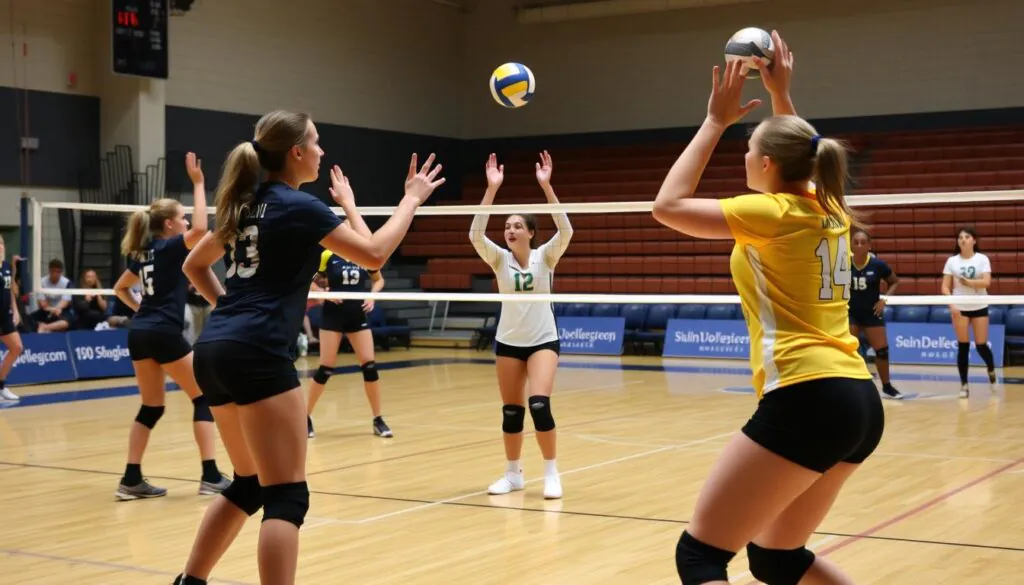
Volleyball defense needs everyone to work together. Blockers and floor defenders must read the game as one. This teamwork is key to success.
Block-Defense Coordination
Good blocking starts with knowing your role. Players must move together like a well-oiled machine. This way, they can stop attacks before they start.
- Synchronize blocker and backcourt defender movements
- Establish clear visual and verbal communication channels
- Practice rapid defensive transition strategies
Communication Systems
Clear communication is vital for defense. Players use words and body language to warn each other. This helps them adjust fast to threats.
| Communication Type | Purpose | Effectiveness |
|---|---|---|
| Verbal Calls | Immediate threat identification | High |
| Hand Signals | Silent positioning guidance | Medium-High |
| Eye Contact | Quick defensive adjustments | High |
Defensive Coverage
Good defense means covering all areas of the court. Reading hitters helps teams set up the right defense. This way, they can stop attacks before they start.
“Defense wins championships in volleyball – it’s about anticipation, not just reaction.”
Team Positioning
Teams need to be able to move fast to defend. They must be ready to change their formation quickly. This keeps the court covered at all times.
- Maintain athletic ready stance
- Shift weight for quick movements
- Stay connected with teammates
Advanced Blocking Techniques
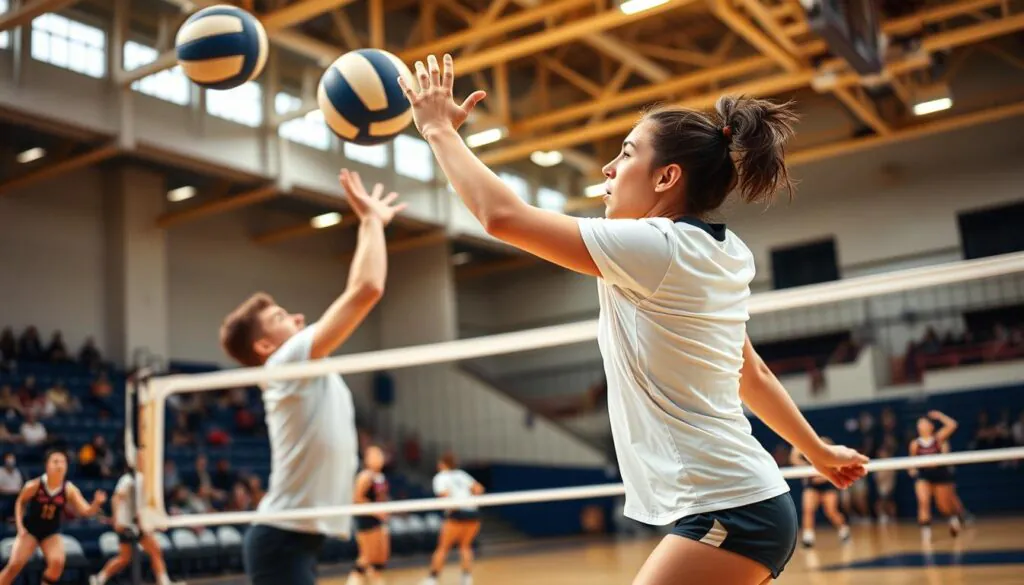
Mastering volleyball blocking techniques is more than just basic skills. It requires a deep understanding of defensive strategies. Professional players must read hitters with great skill, combining mental and physical preparation.
Successful blockers turn defensive play into a proactive strategy. They develop complex skills that make a big difference. Let’s dive into advanced blocking techniques to improve your volleyball game.
Reading Multiple Attackers
Handling multiple attackers is a big challenge in volleyball defense. Skilled blockers need to:
- Quickly figure out where the hits might come from
- Focus on the most dangerous spots
- Guess what the setter might do next
- Keep an eye on all front-row players
Adjustment Strategies
Blocking unexpected plays requires fast thinking. Middle blockers should:
- Keep a low, ready stance
- Stand about 1.5-2 feet from the net
- Use flexible footwork
- Stay in touch with back-row defenders
Block Touch Efficiency
After blocking, controlling the ball’s direction is key. Advanced techniques include:
| Technique | Purpose | Skill Level |
|---|---|---|
| Independent Hand Movement | Anticipate Different Hitting Angles | Advanced |
| Shoulder Locking | Increase Block Stability | Intermediate |
| High Net Reach | Cover Larger Blocking Area | Professional |
Emergency Response Tactics
When standard blocking doesn’t work, quick thinking is essential. Stay ready for surprises like off-speed attacks or setter dumps.
“Blocking is not just about height or strength, but about reading the game and making intelligent defensive choices.” – USA Volleyball Coaching Manual
Mental Aspects of Blocking

Volleyball blocking is as much a mental game as it is a physical skill. Successful defenders know that reading hitters is more than just physical moves. It needs a sharp, focused mind and strategic thinking.
Mastering volleyball blocking techniques is not just about physical skills. The mental game is key in defensive strategies. It can make or break a team’s performance.
Decision-Making Process in Blocking
Blockers must learn to make quick decisions. They need to:
- Quickly assess the setter’s position
- Evaluate possible hitting angles
- Predict the hitter’s likely attack
- Choose the best blocking approach
Developing Anticipation Skills
Anticipation is key in reading hitters well. Players can improve their anticipation by:
- Studying opponent hitting patterns
- Recognizing visual cues in approach
- Understanding body language signals
- Practicing mental visualization techniques
| Mental Skill | Key Strategies | Performance Impact |
|---|---|---|
| Focus | Meditation, concentration drills | Improved reaction time |
| Anticipation | Pattern recognition, video analysis | Better defensive positioning |
| Confidence | Visualization, positive self-talk | Increased blocking effectiveness |
“In volleyball, your mind is your most powerful weapon on the court.” – Professional Volleyball Coach
Mental preparation turns good blockers into top defenders. They can read and stop even tough attacks.
Practice Drills and Improvements
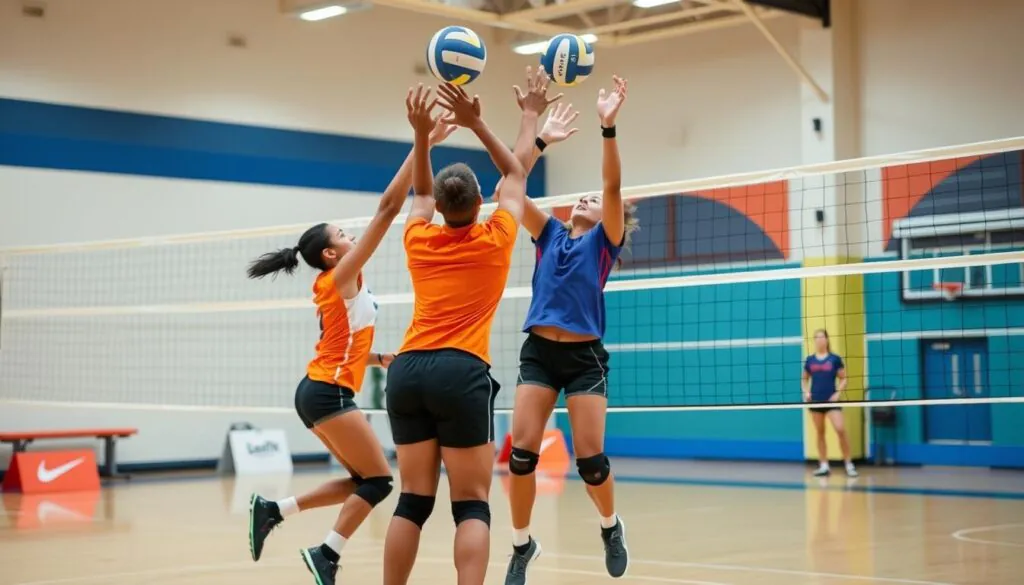
Getting better at volleyball blocking needs focused practice and smart training. We’ll look at drills that boost your defense and help you read hitters better.
Reading Drill Progressions
Learning to read hitters starts with structured drills. Our suggested steps include several key exercises:
- The Shuffling Drill: Players practice moving laterally, forward, and backward quickly
- The Queen of the Court warm-up: It helps players understand strategic attacks from behind the three-meter line
- The Belly Drill: It teaches players to quickly recover and position themselves
Reaction Time Exercises
Quick defensive moves make a big difference. Coaches suggest drills to improve reflexes:
- Defensive Run Thru: It focuses on footwork and defending medium-height balls
- Bail Drill: It’s a competitive drill for defensive training with constant ball attacks
- Passing Ladder: It boosts serve reception accuracy
Pattern Recognition Training
Knowing offensive patterns is key for good blocking. Our training focuses on:
- Studying how hitters approach
- Reading body language
- Spotting pre-hit movement patterns
Team Blocking Scenarios
Blocking as a team needs clear communication and synchronized actions. Important team scenarios include:
- Russian Passing drill for team coordination
- Matrix Drill for intense server challenges
- Outside Hitting scenarios to practice full-team defense
“Practice doesn’t make perfect. Perfect practice makes perfect.” – Vince Lombardi
Conclusion
Mastering volleyball blocking needs a mix of physical skills, mental strategy, and learning. Reading hitters well is a skill gained through practice and studying opponents’ moves. It’s an art.
Players serious about defense must learn the details of blocking. They need to study how sets are set up, analyze the angles of approaches, and make quick decisions. This turns defense from just reacting to being proactive.
Training should focus on both individual skills and teamwork. Perfect blocks come from players working together. Each one knows their part, expects attacks, and moves with precision. The best teams see blocking as a shared effort, not just individual actions.
Blocking in volleyball is a skill that grows with time, discipline, and a desire to get better. With focused practice, mental prep, and a willingness to learn, players can improve their defense. They become key players on the court.
